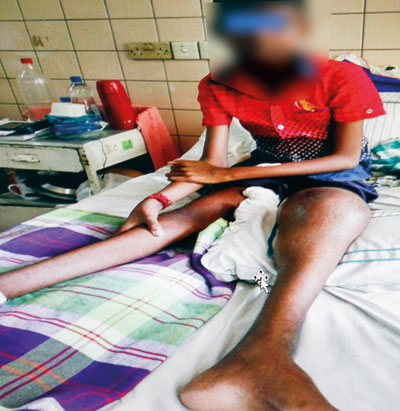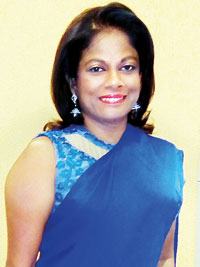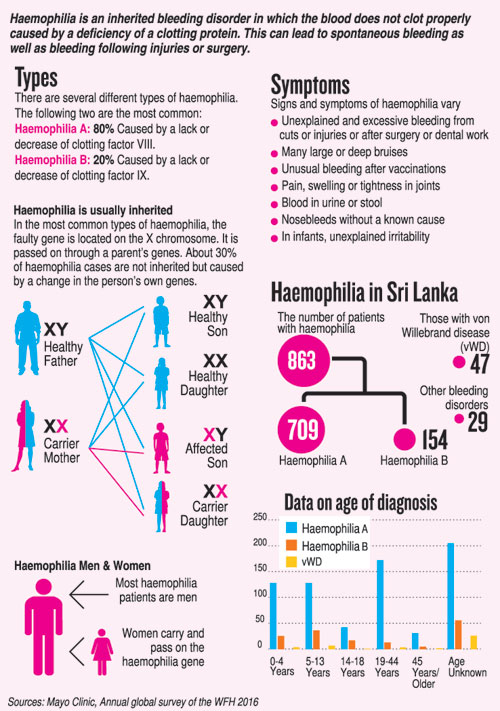A family inheritance that needs medical attention
He was the most prominent figure worldwide to be associated with this inherited bleeding disorder, for he was the heir-apparent of the House of Romanov, due to sit on the throne of the Russian Empire.

A patient with haemophilia whose left knee-joint has been harmed by the bleeding
The youngest and only son of Emperor Nicholas II and Empress Alexandra Feodorovna, Alexei Nikolaevich had inherited haemophilia from his mother.
Keeping his disease under wraps, he was also closely guarded to make sure he would not sustain an injury. Alexei, however, never ascended the throne, for the Emperor’s family was imprisoned during the Great October Revolution of 1917 and the teenager was executed 100 years ago in July.
What is haemophilia?
It is to Consultant Haematologist Dr. Chitranga Kariyawasan of the
Sri Jayewardenepura General Hospital that MediScene turns to, for when she was elected President of the Sri Lanka College of Haematologists in 2015 she turned a sharp focus on haemophilia. She worked towards establishing four dedicated centres for the management of this disorder, expanding the already existing six by these four. Within three short years, there are 16 state institutions across the country for the management of these patients now.
Haemophilia is an inherited (genetic) bleeding disorder, says Dr. Kariyawasan, explaining that it is an X-linked recessive disorder, predominantly affecting males. Females are usually carriers. When haemophilia is inherited, the severity of the disease would be the same throughout that family line or pedigree. The severity varies from ‘mild’ to ‘moderate’ to ‘severe’.
In Sri Lanka, those actively involved in the management of haemophilia are the Sri Lanka College of Haematologists, the Haemophilia Association of Sri Lanka (HASL) and the Health Ministry with the support of the World Federation of Haemophilia.
Taking a closer look at the genetic profile, Dr. Kariyawasan says that among the chromosomes, the X and the Y are the sex chromosomes, with the gene for haemophilia on the X chromosome. A baby-girl will inherit two X chromosomes, one from her mother and the other from her father (XX). A baby-boy will inherit an X chromosome from his mother and a Y chromosome from his father (XY). If the baby-boy inherits an X chromosome carrying haemophilia from his mother, he will have haemophilia. Fathers, however, cannot pass haemophilia to their sons.

Dr. Chitranga Kariyawasan
Even if the baby-girls of a mother who has the haemophilia gene, inherit that gene from her, because they have two X chromosomes (the other a healthy one from the father), they are unlikely to have haemophilia. A baby-girl who inherits an X chromosome that contains the gene for haemophilia becomes a carrier.
For a woman-carrier, the likely outcomes of a pregnancy are:
A baby-daughter who is not a carrier
A baby-daughter who is a carrier
A baby-son without haemophilia
A baby-son with haemophilia
In the case of a woman-carrier marrying someone who is a haemophiliac, there is the possibility of Lyonization. This is the random inactivation of an X chromosome in early embryonic development, the name being derived from geneticist Mary Lyon, it is learnt.
“When we come across a patient with haemophilia, there is almost always a family history and when we look back, we find that the mother’s side has had it, maybe her brother or an uncle etc.,” says Dr. Kariyawasan, pointing out that genetic mutations are rare but can occur in about 1/3rd of the patients without a family history.
She recalls how as a post-graduate doctor serving at the National Hospital of Sri Lanka (NHSL) in Colombo, she saw her first patient with haemophilia.
“It was a 17-year-old who had developed deformities, as at that time he had not been diagnosed properly and not monitored properly. He had kept bleeding into the joints,” says Dr. Kariyawasan, adding that it was “pathetic”. He had a long hospital stay and his joint damage was beyond repair. He needed joint replacement but unfortunately his family could not afford it.
Depending on the severity of the disease, those with haemophilia present the signs and symptoms at birth, during the neonatal period (early infancy), childhood or teenage years. The signs in neonates would be bleeding patches at birth, with some, in rare cases, having intracranial haemorrhaging.
MediScene learns that according to 2016 data, there are 863 patients with haemophilia in the country. With the disorder being grouped into two, 709 patients are in the commoner Haemophilia A category, with the balance 154 coming under Haemophilia B. Forty-seven have von Willebrand disease, while 29 have other bleeding disorders.
Dr. Kariyawasan gets down to specifics as she explains that when a baby starts to crawl, if he is having haemophilia, he would start bleeding at the knees. ‘Mild’ haemophilia will manifest as bruises and bleeding patches, while in the ‘moderate’ form there could be bleeding into joints and muscles, if there is trauma. However, in the ‘severe’ form, there is spontaneous bleeds into the joints and muscles.
According to this Haematologist:
Haemophilia A – This is ‘classic’ haemophilia in which either Factor VIII (FVIII), a blood-clotting protein in blood plasma, is missing or deficient.
Usually, in normal people, the plasma levels of FVIII range from 50% to 150%.
Those with ‘mild’ Haemophilia A have only 6% to 49% of FVIII in their blood. They will have prolonged bleeding only after a serious injury, trauma or surgery.
 Those with ‘moderate’ Haemophilia A have only 1% to 5% of FVIII in their blood. They will get bleeding episodes after injuries.
Those with ‘moderate’ Haemophilia A have only 1% to 5% of FVIII in their blood. They will get bleeding episodes after injuries.
Those with ‘severe’ Haemophilia A have only <1% of FVIII in their blood. They will have bleeding following an injury and also frequent spontaneous — without an obvious cause — bleeding often into their joints and muscles.
Haemophilia B – The cause is the missing or deficient Factor IX (FIX).
Usually, the plasma levels of FIX range from 50% to 150% in a normal person.
Those with ‘mild’ Haemophilia B have only 6% to 49% of FIX in their blood. They have prolonged bleeding only after serious injury, trauma, surgery and tooth extraction and tend to get diagnosed only then.
Those with ‘moderate’ Haemophilia B have only 1% to 5% of FIX in their blood. They tend to have bleeding episodes after injuries.
Those with ‘severe’ Haemophilia B have only <1% of FIX in their blood. They bleed following an injury and may have frequent spontaneous bleeding episodes into their joints and muscles.
von Willebrand Disease (vWD) – This is due to the von Willebrand Factor (vWF) being missing or defective. vWF is a clotting protein, which binds Factor VIII and platelets in blood vessel walls and helps form a platelet plug during the clotting process.
Meanwhile, in both Haemophilia A and B, the carriers will have more than 30% of FVIII and FIX respectively and as such will not have any symptoms, MediScene learns.
Dr. Kariyawasan says that it is important to get a detailed medical history of the patient to find out whether relatives have been diagnosed with a bleeding disorder. The tests to determine haemophilia include the evaluation of blood-clotting time and a clotting factor test or assay to zero-in on the type of haemophilia as well as its severity.
The products to treat haemophilia include cryoprecipitate, plasma-derived concentrate, recombinant concentrate (excluding prolonged half-life and prolonged half-life) and DDVP (desmopressin).
There are many hospitals treating haemophilia across the country and include the NHSL; the Lady Ridgeway Hospital (LRH) for Children in Colombo; the Teaching Hospitals of Colombo South (Kalubowila), Kurunegala, Anuradhapura, Jaffna, Karapitiya, Badulla and Peradeniya; the Sirimavo Bandaranaike Hospital in Peradeniya; the District General Hospitals of Ratnapura, Chilaw, Hambantota and Matara; and the Base Hospitals of Embilipitiya and Kuliyapitiya.
Several of these centres give patients direct access under one roof to a haemophilia doctor, a nurse, a physiotherapist and a special coagulation laboratory.
Explaining that haemophilia patients are being provided acute management (injection of factor and prophylaxis) as well as home therapy (low-dose factor replacement) and supportive care (blood transfusions, tranexamic acid, physiotherapy and dental care), she says that there is also a referral system to dental and other units, with social worker support starting at a few centres.
The doctors who are treating haemophilia have to be alert to the danger of patients developing inhibitors (antibodies) in the blood to fight off what the body sees as a ‘foreign’ invader which in fact is really the foreign factor proteins, she warns, as this will stop the factor concentrates from fixing the bleeding problem. In the management of patients in Sri Lanka, only four developed inhibitors in 2016 and were treated with immune tolerance induction (ITI).
Not content with resting on her laurels, Dr. Kariyawasan says that more needs to be achieved including a system to care for the disabled, genetic testing for carrier detection, a database and network among centres, training of physiotherapists and the issuance of identity cards to patients with proper registration numbers so that they can carry them with them.
| HASL: Leading the way in haemophilia care The Haemophilia Association of Sri Lanka (HASL), founded in 1998 has become proactive since 2015 and been exploring ways and means through which to improve and strengthen haemophilia care in the country.Working closely with the Sri Lanka College of Haematologists, the HASL is set on improving musculoskeletal care to prevent complications and disabilities and educating and empowering patients. The HASL may be contacted on e-mail: lalla_gun@yahoo.com or Phone: +94112894451 or +94812499796 | |


